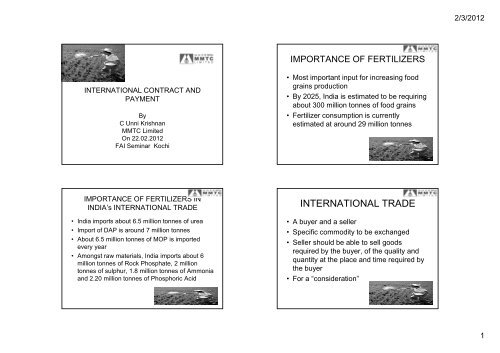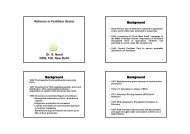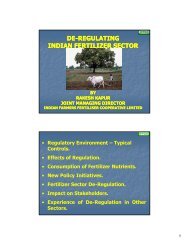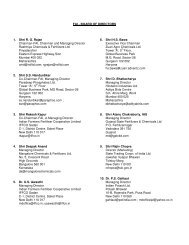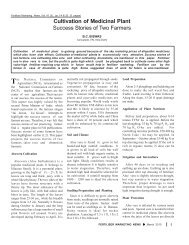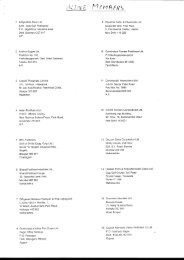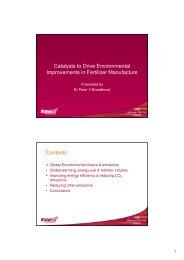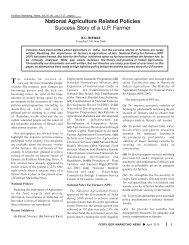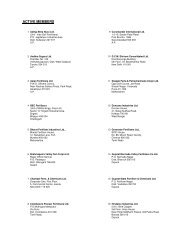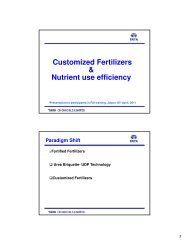International Contracts for Import of Fertilisers - The Fertiliser ...
International Contracts for Import of Fertilisers - The Fertiliser ...
International Contracts for Import of Fertilisers - The Fertiliser ...
You also want an ePaper? Increase the reach of your titles
YUMPU automatically turns print PDFs into web optimized ePapers that Google loves.
2/3/2012<br />
IMPORTANCE OF FERTILIZERS<br />
INTERNATIONAL CONTRACT AND<br />
PAYMENT<br />
By<br />
C Unni Krishnan<br />
MMTC Limited<br />
On 22.02.2012<br />
FAI Seminar Kochi<br />
• Most important input <strong>for</strong> increasing food<br />
grains production<br />
• By 2025, India is estimated to be requiring<br />
about 300 million tonnes <strong>of</strong> food grains<br />
• Fertilizer consumption is currently<br />
estimated at around 29 million tonnes<br />
IMPORTANCE OF FERTILIZERS IN<br />
INDIA’s INTERNATIONAL TRADE<br />
• India imports about 6.5 million tonnes <strong>of</strong> urea<br />
• <strong>Import</strong> <strong>of</strong> DAP is around 7 million tonnes<br />
• About 6.5 million tonnes <strong>of</strong> MOP is imported<br />
every year<br />
• Amongst raw materials, India imports about 6<br />
million tonnes <strong>of</strong> Rock Phosphate, 2 million<br />
tonnes <strong>of</strong> sulphur, 1.8 million tonnes <strong>of</strong> Ammonia<br />
and 2.20 million tonnes <strong>of</strong> Phosphoric Acid<br />
INTERNATIONAL TRADE<br />
• A buyer and a seller<br />
• Specific commodity to be exchanged<br />
• Seller should be able to sell goods<br />
required by the buyer, <strong>of</strong> the quality and<br />
quantity at the place and time required by<br />
the buyer<br />
• For a “consideration”<br />
1
2/3/2012<br />
MAIN ACTIVITIES IN<br />
INTERNATIONAL TRADE<br />
• Contracting<br />
• Documentation<br />
• Payments<br />
• Infrastructure<br />
• Chartering<br />
• Insurance<br />
Process Leading to <strong>Contracts</strong><br />
• Identification <strong>of</strong> Business Opportunity<br />
• Identification <strong>of</strong> supply sources and buyers<br />
• Establishing right price mainly through tenders –<br />
open or limited<br />
• Receipt <strong>of</strong> Offers against tender<br />
– First stage : techno commercial<br />
– Second stage : price bid<br />
• Evaluation <strong>of</strong> Offers<br />
• Deciding on buyer/seller leading to contract<br />
WHY CONTRACTS<br />
• Required as buyers and sellers are unknown<br />
to each other<br />
• Seller <strong>of</strong>fers<br />
• Buyer Accepts<br />
• When <strong>of</strong>fer and acceptance is absolute<br />
and unqualified – it is a contract<br />
What is a Contract<br />
• Legally binding exchange <strong>of</strong> promise or<br />
agreement between parties<br />
• En<strong>for</strong>ceable by Law<br />
• Breach <strong>of</strong> Contract is recognised by Law<br />
and remedies are available<br />
2
2/3/2012<br />
Key Legal Elements<br />
• Offer and Acceptance<br />
• Consideration<br />
• Intention to Create Legal Relationship<br />
Different Types <strong>of</strong> <strong>Contracts</strong><br />
• Long-term <strong>Contracts</strong><br />
• Transaction to transaction contracts<br />
• Contract <strong>for</strong> buying<br />
• Contract <strong>for</strong> selling<br />
• High-seas sales contract<br />
<strong>Contracts</strong> in Intl Trade<br />
• Most important and integral document<br />
• Two kinds <strong>of</strong> contracts<br />
– One with the suppliers<br />
– Another with customers<br />
• All documents flow from contracts<br />
• Fine tuning contractual terms most difficult<br />
• Standardization becoming difficult<br />
<strong>Contracts</strong> (Contd)<br />
• Competitiveness <strong>of</strong> marketing reduces<br />
manoeverability<br />
• Consolidation on the supply side overseas<br />
• Hence, contract becomes an instrument<br />
<strong>for</strong> adding value in the chain, which is<br />
most important<br />
3
2/3/2012<br />
Difficulties in Contracting<br />
• Standardization <strong>of</strong> the terms becoming<br />
difficult<br />
• Suppliers have their own standard terms<br />
• With movement <strong>of</strong> cargo increasing,<br />
shipping terms have become highly cost<br />
sensitive<br />
Difficulties in Contracting (Contd..)<br />
• Minute details deserve major attention<br />
• Despatch/Demurrage rates becoming<br />
highly important<br />
• Pre-berthing delays are common now<br />
(delays be<strong>for</strong>e vessels are berthed)<br />
• Knowledge <strong>of</strong> shipping terms a must<br />
USUAL TERMS OF FERTILIZER<br />
CONTRACTS<br />
• Buyer and Seller<br />
• Commodity<br />
• Detailed specifications<br />
• Quantity (Tolerance)<br />
• Price (based on INCO terms)<br />
• Shipment Schedule<br />
• Packing wherever required<br />
• Delivery Terms<br />
• Shipping Terms<br />
• Payment Terms<br />
• Documents<br />
• Arbitration<br />
• Force Majeure<br />
• General Terms<br />
INCO Terms<br />
• Developed, maintained and promoted by<br />
ICC (<strong>International</strong> Chamber <strong>of</strong> Commerce)<br />
• To make international trade easier<br />
• First introduced in 1936 by ICC<br />
• Latest edition in 2010<br />
• 11 Inco Terms in all<br />
4
2/3/2012<br />
INCO Terms (contd)<br />
INCO Terms usually used<br />
• <strong>The</strong> 13 Terms<br />
– EXW (Ex-works)<br />
– FAC (Free Carrier)<br />
– FAS (Free Along Side)<br />
– FOB (Free On Board)<br />
– CFR (Cost and Freight)<br />
– CIF (Cost, Insurance and Freight)<br />
– CPT (Carriage Paid to)<br />
– CIP (Carriage and Insurance Paid to)<br />
– DDP (Delivered duty paid)<br />
– DAT (Delivered at Terminal)<br />
– DAP (Delivered at Place)<br />
FOB<br />
– Carriage to be arranged by buyer<br />
– Risk pass from seller to buyer once goods cross ship’s rail<br />
– Costs transfer from seller to buyer once goods cross ship’s rail<br />
C&F<br />
– Carriage to be arranged by seller<br />
– Risk pass from seller to buyer once goods cross ship’s rail<br />
– Costs transfer from seller to buyer at the port <strong>of</strong> destination buyer paying<br />
such costs as are not <strong>for</strong> the seller’s account under contract <strong>of</strong> carriage<br />
CIF<br />
– Carriage to be arranged by seller<br />
– Risk pass from seller to buyer once goods cross ship’s rail<br />
– Costs transfer from seller to buyer at the port <strong>of</strong> destination buyer paying<br />
such costs as are not <strong>for</strong> the seller’s account under contract <strong>of</strong> carriage<br />
OTHER INCO Terms<br />
• Delivery Ex Ship (DES) : Goods are placed at<br />
the disposal <strong>of</strong> the buyers on board the ship but<br />
“not cleared <strong>for</strong> import at the named port <strong>of</strong><br />
destination”<br />
• Delivered Ex-quay (DEQ) : Seller makes good<br />
available to the buyer at the quay (Wharf) at<br />
destination nor cleared <strong>for</strong> imports<br />
• Ex Works (EXW) – Goods placed at the disposal<br />
<strong>of</strong> the buyer at the seller’s premises<br />
INCO Terms (Contd)<br />
• Free Carrier (FCA) – Seller delivers<br />
goods, cleared <strong>for</strong> export, to the carrier<br />
nominated by the buyer at named place<br />
• Carriage Paid To (CPT) – Seller delivers<br />
goods to the carrier to named port <strong>of</strong><br />
destination<br />
• Carriage and Insurance Paid to (CIP) –<br />
additional insurance<br />
5
2/3/2012<br />
INCO Terms (Contd)<br />
• Delivered at Frontier (DAF) – goods are placed<br />
at the disposal <strong>of</strong> the buyer at the place at the<br />
frontier<br />
• Delivered Duty Paid (DDP) – Seller delivers<br />
goods the buyer cleared <strong>for</strong> import and not<br />
unloaded from arriving means <strong>of</strong> transport at the<br />
named place <strong>of</strong> destination<br />
• Delivered Duty Unpaid (DDU) – Seller delivers<br />
goods to the buyer not cleared <strong>for</strong> import and<br />
not unloaded from arriving means <strong>of</strong> transport<br />
Financial Instrument – Letters <strong>of</strong><br />
Credit<br />
• Mainly Letters <strong>of</strong> Credit<br />
• Irrevocable without recourse to drawer<br />
• Confirmed<br />
• Negotiation <strong>of</strong> Letter <strong>of</strong> Credit<br />
• Documents <strong>of</strong> Transaction<br />
• Other instruments like DP, etc.<br />
Letters <strong>of</strong> Credit<br />
• Issued by the bankers <strong>of</strong> the buyers to the<br />
bankers <strong>of</strong> the suppliers<br />
• Prescribed as per UCPDC prescribed by ICC<br />
• Means any arrangement whereby issuing bank<br />
acting on the instructions <strong>of</strong> the customer is to<br />
make payment or accepts bills drawn by a<br />
beneficiary or its order or authorises another<br />
bank to accept the bill or make payment against<br />
presentation <strong>of</strong> certain prescribed documents<br />
provided that terms and conditions <strong>of</strong> credit are<br />
complied with<br />
LC (Contd.)<br />
• LC could be revocable or irrevocable – now only<br />
irrevocable<br />
• Normally opening bank, advising bank and<br />
negotiating bank<br />
• LC payable at sight or with usance period<br />
• Confirming bank - Adding “confirmation” to the<br />
credit<br />
• Negotiation means giving value <strong>of</strong> the draft or<br />
the documents<br />
• As per latest amendment, 5 banking days to<br />
each bank <strong>for</strong> acceptance or rejection<br />
6
2/3/2012<br />
LC (Contd.)<br />
• Transferrable Letter <strong>of</strong> Credit<br />
• Divisible Letter <strong>of</strong> Credit<br />
Shipping Documents under LC<br />
• Bill <strong>of</strong> Lading<br />
• Quality Certificate<br />
• Quantity Certificate<br />
• Certificate <strong>of</strong> Origin<br />
• Stowage Plan<br />
• Invoice<br />
• Bill <strong>of</strong> Exchange<br />
OTHER TYPES OF PAYMENT<br />
• Payment under Bill <strong>of</strong> Exchange<br />
- An instrument in writing addressed by<br />
one person (exporter) to another<br />
(importer) signed by the person giving it<br />
requiring the person to whom it is<br />
addressed to pay on demand or at fixed or<br />
determinable future (usance bill <strong>of</strong> draft) a<br />
certain sum <strong>of</strong> money to the named party<br />
Payments (Contd)<br />
• Documents Against Acceptance (DA)<br />
- Drawee gives consent to make<br />
payment <strong>of</strong> the bill amount on the maturity<br />
date by either signing the bill or putting the<br />
date <strong>of</strong> acceptance or writing across the<br />
bill the word “accepted”.<br />
7
2/3/2012<br />
Payments (Contd)<br />
• Documents Against Payment (D/P)<br />
– Where exporter expects payment from the<br />
importer immediately on presentation <strong>of</strong> the<br />
draft<br />
– Till that, negotiating/collecting bank does not<br />
hand over shipping documents.<br />
– Without shipping documents, importer cannot<br />
take delivery <strong>of</strong> the goods<br />
SHIPPING<br />
• Sea Transport predominant due to its being<br />
largest, most economical and environment<br />
friendly<br />
• As per UNCTAD Review, 95% <strong>of</strong> trade by<br />
volume and 75% by value is through sea route<br />
• Most <strong>of</strong> our trade is through Sea Route<br />
• Hence the most important logistic infrastructure<br />
is Port<br />
• Can be divided into Major and Minor Ports<br />
Shipping (Contd)<br />
• Indian ports handle about 600 million tonnes <strong>of</strong><br />
cargo<br />
• <strong>The</strong> aggregate cargo handling capacity is about<br />
one billion tonnes<br />
• Expected to reach 1600 million tonnes by 2025-<br />
26<br />
• Average turn-around improved from 10.10 days<br />
in 1990-91 to 3.85 days in 2008-09<br />
• Average turn-around in Hongkong is 10 hours<br />
Shipping (Cond.)<br />
• Two broad categories – bulk and non-bulk<br />
or break-bulk (normally packed goods)<br />
• India has a coast line <strong>of</strong> 7517 kms<br />
• 12 Major Ports (6 on West Coast and 6 on<br />
East Coast)<br />
• 185 Minor and Intermediate Ports<br />
• Ports handle 95% <strong>of</strong> India’s trade in<br />
volume and 70% in value<br />
• India has 517 ships with GRT 7023951<br />
8
2/3/2012<br />
Shipping (Contd.)<br />
Shipping (Contd.)<br />
ECI<br />
Kolkata/Haldia<br />
Paradeep<br />
Visakhapatnam<br />
Ennore (EPL)<br />
Chennai<br />
Tuticorin<br />
WCI<br />
Cochin<br />
New Mangalore<br />
Mormugao<br />
JNPT<br />
Mumbai<br />
Kandla<br />
OTHER PORT<br />
Major Ports - Advantages<br />
• Major ports managed by Port Trusts<br />
• Ships can berth along-side<br />
• Most <strong>of</strong> the handling <strong>of</strong> cargo mechanical<br />
• Availability <strong>of</strong> Transit Sheds<br />
• Labour is organised<br />
• Hence loading and discharging much<br />
simpler<br />
Minor Ports - Disadvantages<br />
• Minor Ports managed by State Maritime Boards<br />
• Vessels have to anchor outside in the midstream<br />
• Absence <strong>of</strong> floating cranes and hence shipping<br />
cranes may be required<br />
• Barges are used <strong>for</strong> taking material to and from<br />
the vessels<br />
• Very little warehousing facilities available<br />
• Connectivity to the port limited<br />
9
2/3/2012<br />
PORTS (Contd)<br />
. About 60% <strong>of</strong> total fertilizer (about 65 lakh<br />
tonnes) is handled by 11 major ports<br />
. Major ports handling fertilizers are Kandla,<br />
Mundra, Visakhapatnam,Tuticorin, New<br />
Mangalore, Krishnapatnam, Paradip<br />
. 20 Minor ports handle about 40 lakh tonnes <strong>of</strong><br />
fertilizers<br />
. Rozi in West and Kakinada in East are<br />
important minor ports handling fertilizers<br />
EFFICIENCY OF PORTS<br />
• Turn around <strong>of</strong> ships, faster<br />
documentation, evacuation, etc<br />
• No pre-berthing detention<br />
• Discharge rate is higher<br />
• Adequate storage and evacuation facilities<br />
FACTORS DETERMINING<br />
SUITABILITY OF A VESSEL<br />
• LOA<br />
• Draft<br />
• Beam<br />
• Dead weight<br />
• Number <strong>of</strong> holds<br />
• Hatch cover<br />
• Number and capacity <strong>of</strong> cranes<br />
SHIPPING (Contd.)<br />
• Liner - Vessels run on pre-determined<br />
routes<br />
• Tramp – no fixed route and schedule<br />
• Panamax vessels – around 50000 M.T.<br />
Handimax – 25-40000 M.T.<br />
• Chartering – engagement between vessel<br />
owner and the charterer through laid down<br />
terms – such an instrument is called<br />
“Charter Party” or “COA”<br />
10
2/3/2012<br />
SHIPPING (Contd.)<br />
• Voyage Charter – owner gets freight per tonne<br />
<strong>of</strong> cargo<br />
• Time Charter – vessel chartered <strong>for</strong> a particular<br />
period (shipowner responsible <strong>for</strong> cost <strong>of</strong> crew,<br />
depreciation, wages, stroes, provisions,<br />
insurance, etc whereas charterer responsible<br />
<strong>for</strong> costs <strong>of</strong> fuel, port charges, stevedoring, etc)<br />
• Bareboat Charterer – Charterer becomes the<br />
defacto owner and manages the vessel (in bare<br />
<strong>for</strong>m without crew, etc,)<br />
SHIPPING (Contd)<br />
• Consecutive Voyages – Owners undertake<br />
to per<strong>for</strong>m certain fixed number <strong>of</strong><br />
voyages<br />
• Contract <strong>of</strong> Affreightment (COA) – Owner<br />
and charterer agree to transport certain<br />
quantity <strong>of</strong> cargo from one port to another<br />
during a fixed period at an agreed freight<br />
Shipping (Contd.)<br />
• For bulk commodities, in tramps (large<br />
vessels), single deck gearless vessels in<br />
large sizes are preferred<br />
• In Liner vessles (small vessels) generally<br />
use tween-deck geared vessels<br />
CHARTER PARTY<br />
• Contract by which shipowner agrees to place<br />
ship at the disposal <strong>of</strong> a charterer <strong>for</strong> carriage <strong>of</strong><br />
goods from one port to another or <strong>for</strong> a specified<br />
period<br />
• Shipowner and charterer normally negotiates<br />
through a ship broker<br />
• Standard <strong>for</strong>ms <strong>of</strong> Charter party are Baltic<br />
<strong>International</strong> Maritime Conference (BIMCO),<br />
Federation <strong>of</strong> Natioal Associations <strong>of</strong> Ship<br />
Brokers and Agents (FONASBA), etc.<br />
11
2/3/2012<br />
Elements <strong>of</strong> Charter Party<br />
• Vessel owner and charterer<br />
• Description <strong>of</strong> vessels, Voyage, etc.<br />
• Laycan – Period during which ship is required to<br />
reach the load port<br />
• NOR<br />
• Freight<br />
• Cargo<br />
• Name <strong>of</strong> the Ports – loading/discharging<br />
• Demurrage/Despatch Rate<br />
• Exclusion/inclusion – SHEX/SHINC<br />
Charter Party (Contd.)<br />
• Loading and discharging rates/terms<br />
• Laytime – time allowed by the owners to<br />
the charterers <strong>for</strong> completing cargo<br />
operations without extra payment<br />
• Force Majeure<br />
• Arbitration<br />
CARGO INSURANCE<br />
• Marine insurance protection to damage or loss<br />
<strong>of</strong> goods (and not <strong>for</strong> payment or exchange risk)<br />
• Two reasons : Legal dimension and commercial<br />
dimension<br />
• Legal dimension – goods in custody <strong>of</strong> different<br />
people at different stages<br />
• Commercial dimension – since goods and<br />
payments exchanged through documents, both<br />
buyer and seller have risk at some point<br />
Insurance (Contd.)<br />
• Loss covered in the policy as a result <strong>of</strong> various<br />
perils to be defined<br />
• “Causa Proxima” means the active, efficient, cause<br />
that sets in motion a train <strong>of</strong> events which brings<br />
about a result, without the intervention <strong>of</strong> any <strong>for</strong>ce<br />
started and working actively from a new and<br />
independent source” e.g. theft/pilferage but loss due<br />
to unworthy packing<br />
• Kinds <strong>of</strong> Perils : Maritime perils<br />
: Extraneous Perils<br />
: War Perils<br />
: Strike Perils<br />
12
2/3/2012<br />
Marine Insurance (Contd)<br />
• Maritime Perils – Perils to which cargo is<br />
exposed in transit<br />
• Extraneous Perils – Incidental perils caused<br />
mainly on account <strong>of</strong> faults in loading, keeping,<br />
carrying and unloading<br />
• War Perils – caused by war, civil war, revolution,<br />
rebellion, capture, seizure, arrest, etc.<br />
• Strike Perils – caused by strikes, lock outs,<br />
political motive, etc.<br />
Types <strong>of</strong> Insurance Policies<br />
• Specific Voyage Policy – risks that may<br />
arise during a voyage from one place to<br />
another<br />
• Open Cover – used by large international<br />
trading companies<br />
• Open Policy - covers a series <strong>of</strong><br />
consignments, <strong>for</strong> an agreed amount<br />
CONCLUSION<br />
• Contract – most important document<br />
• No contract is ever complete<br />
• Even the most carefully drafted document<br />
rests on volumes <strong>of</strong> assumptions<br />
• A well written contract help limit misunderstandings<br />
• Everything else flows from the contract<br />
• Essential to understand international<br />
trading terms<br />
Conclusion (Contd.)<br />
• Equally important to know the financial<br />
instruments – specially Letter <strong>of</strong> Credit<br />
• Shipping is fundamental to international<br />
trade and hence important <strong>for</strong> all <strong>of</strong> us<br />
• Insurance is an important element <strong>of</strong><br />
international trade<br />
• Knowledge and up-dation <strong>of</strong> the above<br />
add to sharpening <strong>of</strong> our skills<br />
13
2/3/2012<br />
CONCLUSION (Contd…)<br />
• Objective is to become not only “good<br />
writers <strong>of</strong> the contracts” but also “good<br />
executors <strong>of</strong> contracts<br />
• Business is risky, trading is riskier and<br />
<strong>International</strong> trading is the riskiest.<br />
• It is thus a specialized job and must be<br />
handled pr<strong>of</strong>essionally.<br />
• Hence, leave it to organizations like …..<br />
By C Unni Krishnan<br />
14


